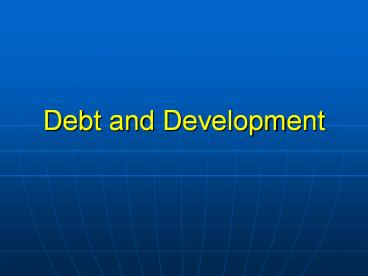Debt and Development - PowerPoint PPT Presentation
1 / 13
Title:
Debt and Development
Description:
4) Recession, stagnation, and huge bank deposits meant money was cheap! ... Capital flight. ... Capital flight makes it impossible for the Mexican government to ... – PowerPoint PPT presentation
Number of Views:80
Avg rating:3.0/5.0
Title: Debt and Development
1
Debt and Development
2
GNP Per Capita by Region
3
Origins of Third World Debt (1)
- In the first decades after decolonisation,
official lenders were main source for Third World
credit. - 1973 Oil Crisis gt flows of money from oil
consumers to producers. - Oil producers place deposit money in offshore
international banks. - Oil crisis provokes stagflation (inflation and
stagnant growth) in the core countries.
4
Origins of Third World Debt (2)
- Consequences of stagflation
- 1) Decline in aid flows from core to Third World.
- 2) Declining demand in the core for Third World
exports - 3) Non oil producing nations also had to import
the more expensive oil. - 4) Recession, stagnation, and huge bank deposits
meant money was cheap! Real interest rates were
negative. But, this was nonconcessional lending
(variable rates).
5
Domestic Causes of the Debt Crisis
- Loans were used to finance middle class
consumption. - Corruption led to waste and ill-conceived
projects, inappropriate technology. - Capital flight. Funds ended back overseas, often
in the same banks that had lend it in the first
place. - Military spending.
6
International Causes of the Crisis
- Huge size of US budget deficit, caused by high
military spending. This forces up interest rates
(to attract credit to cover the deficit). This
pushes up world interest rates. - Second oil crisis, 1979. US tries to control
inflation through raising interest rates gt
disaster for the Third World debtors.
7
The Mexican Crisis, 1982.
- Mexico displays all the symptoms of an impending
crisis. - Capital flight makes it impossible for the
Mexican government to service its debts. - Mexicos default causes an international debt
crisis as banks recognise their exposure to bad
loans. Private flows to the Third World halted.
8
The International Monetary Fund
- Third World debtors have no choice but to ask IMF
for a bailout. - However, IMF bailouts have conditionalities.
- Structural adjustments involves macroeconomic
reform and structural reform.
9
Structural Adjustment (Macroeconomic Reform).
- Exchange rate reforms devaluation of currency
brings unemployment and welfare cuts. - Decrease in wages and flexiblisation of labour.
- Central bank independence government can no
longer use monetary policy. - Budget deficit reductions
- An end to state investment.
10
Structural Adjustment (2) (Structural Reform)
- Trade liberalisation decline in customs
revenues, thus an impact on states finances. - Privatisation of state enterprises
- Deregulation of the banking system government
loses ability to target credit towards local
producers. - Liberalisation of the capital movement foreign
exchange is allowed to move freely in and out of
the country.
11
The South Korean Exception
- In 1983, South Korea (43 billion), Brazil (98
billion), Mexico (93 billion), Argentina (45
billion). - Korea did not become subject to IMF
restructuring. Why the difference? - Bailout of Korea by Japan, not IMF.
- Why? 1) Strategic importance of Korea to Japan
2) Korea was indebted to Japanese banks - Thus, Korea did not have to undergo structural
adjustment.
12
Debt Forgiveness?
- Against
- - the problem of moral hazard.
- For
- 1) Why should governments inherit debt?
- 2) Failure of indebted governments to provide
essential services due to debt. - 3) Disparity between personal debt and sovereign
debt.
13
Attempts at dealing with debt crisis
- 1980s, Baker and Brady Plans.
- The Paris Club Arrangements.
- Debt-for-equity swaps.
- Heavily Indebted Poor Countries Initiative (HIPC)
still has strict conditionalities. - Multilateral Debt Relief Initiative aimed at
cancelling more debt, but only for countries that
have been through the HIPC.

